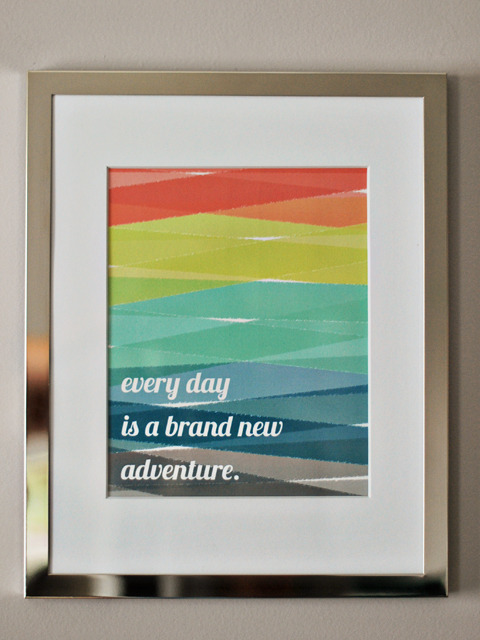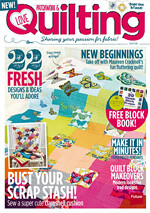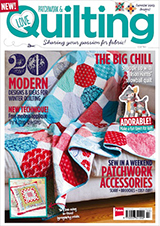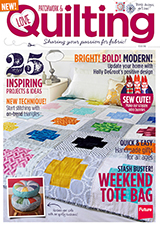I think it's about time I started posting some quilting basics for those of you who are just starting to get into quilting! I'm going to start near the end of the quilting process to supplement my patterns and tutorials, but maybe we can head back to the beginning stages with a simple quilt tutorial sometime soon.
Today we're going to talk about how to make your own straight-grain binding! The advantages to straight grain binding over bias binding are that it uses less fabric and is easier to cut. It can be used for square and rectangular quilts, anything with straight edges! Once you get into curved edges, you'll want to use bias binding instead.

Alright, let's get started. First of all, you'll need to calculate how much binding you'll need to make. Let's do some quilt math.
I'm making a little baby quilt here, so my dimensions are 35" x 42". I am making a thicker binding, so I'm going to cut my strips at 3" wide. So plugging those numbers into my equation:
2* 35" + 2*42" + 6" = 160"
160" / 40" = 4 strips
4 strips*3" / 36" = 1/3 yard of fabric required for binding
So now I know I need to cut 4 strips, and if I cut each one at 3" wide, I'll need 1/3 yard of fabric for binding. Now we can actually start making our binding!
1. Cut your binding strips. I like the look of a thicker binding, so I cut my strips 3" wide and attach them to my quilt with a 3/8" seam allowance, so the entire binding is filled with batting. If you like the look of a thick binding and the edges of your quilts don't have any points that you could potentially cut off, this is the width that I recommend. If your quilt does have points along the edges, or you prefer a standard thickness binding, I suggest using a 1/4" seam allowance and cutting your binding strips at 2.5" wide instead.
Once you've figured out what width you're going to cut, line the folded edge up with a line on your cutting mat and square up the edge of the fabric. Then measure in from there to your desired width (3" in this picture) and cut your strip.
Continue this process until all of your required strips are cut.
2. Lay two strips right sides together at a 90 degree angle. To do this, lay one strip on your cutting mat right side facing up, aligning the top edge of the usable fabric (below the selvage) with a horizontal line on your mat, and making sure that the strip follows the vertical line of your mat as well. Place another strip on top of the first strip, with the wrong side of the fabric facing up (so both strips are right sides together). If you align the top edge of the usable fabric of this strip with the left edge of the first strip, and make sure that the length of the strip follows the horizontal line of your mat, your fabrics should be at a 90 degree angle.
3. Pin strips together. Place one pin in the top right corner, and one in the bottom left corner.
4. Mark a diagonal line at the intersection points of the two strips, from the bottom left corner to the top right corner. You can use a fabric pen or a pencil, the marks will be hidden in the seam when you're finished.
5. Flip your strips open so the right side of top strip is facing up. You are going to pin the next strip to the other end of this top strip. Find the end of the strip, and repeat steps 3-4 to join the ends of those strips. Continue this process until all of your strips are joined.
6. Stitch along the line to connect each of the binding strips. Continue until all of your strips are connected.
7. Trim the seam allowance of the joined edges of the strips to 1/4". You can trim the dog ears that are left after making your 1/4 seam allowance as well if you want.
8. Press the joining seams between each of your strips open.
9. Fold binding in half, starting at one edge and pressing as you go until you reach the other end of the binding.
10. Cut one end of your binding at a 45 degree angle. Open the end of your folded binding and make sure that the long edge of the strip is on your left side, and your angle is established from top left to bottom right, as shown in the picture.
When you fold your binding back in half, if you cut correctly, it should look like the picture below when the raw edge is on the bottom and the length of your strip is to your left. You will see why this is important when we attach it to the quilt!
11. Fold the bias edge that you just cut over at least 1/2" and press.
It will look like this when you fold it in half again.
12. Trim off the excess little triangle you see in the picture above (it's cut off in the picture below).
Your binding is finished! Roll it up and get ready to attach it to your quilt.
Other posts in this series:























 Welcome to Bijou Lovely. This blog is named after my great grandmother, Bijou Lillian, who encouraged me to embrace all the lovely things that the world has to offer. I hope to provide you with inspiration for sewing, quilting, photography, design, and daily life here at Bijou Lovely! It's truly lovely to have you here.
Welcome to Bijou Lovely. This blog is named after my great grandmother, Bijou Lillian, who encouraged me to embrace all the lovely things that the world has to offer. I hope to provide you with inspiration for sewing, quilting, photography, design, and daily life here at Bijou Lovely! It's truly lovely to have you here.














This is a wonderful tutorial Holly! I will be definitely sending my readers this way when we talk about binding in a few weeks during the Beginner's Quilting Series. Thank you!
ReplyDeletegreat tute holly!
ReplyDeleteok, i thought i knew it all about binding, but that little trick you did at the end has me all confused! where is thing going? this is a real cliffhanger for me!
ReplyDeleteand maybe you already know about this, but just last night i downloaded the robert kaufman quilt calc app to my iphone. i know figuring out how much binding you need to do isn't that difficult, but this thing does it for you in seconds! and there's a bunch of other quilt calculations it does, too. super cool and totally worth it... especially since it's free!
Great tutorial! Thank you for making it... and for putting up how to calculate how much material you will need for the binding. I usually just guestimate (yes that is a technical term hehe) and end up with a bit extra.
ReplyDeleteGreat tutorial but I was highly distracted by that lovely quilt in the background. ;) can't wait to see that reveal!
ReplyDeleteThat is totally my favorite print for binding...quite possibly in the history of ever!! LOL!
ReplyDeleteArajane's right, I love that little RK app, it has lots of other quilt math options on it, too, like a backing calculator, a pieces to yardage calculator, and so forth.
Can't wait to see your Nursery Versery quilt all finished up, so pretty!
Lovely tutorial, Holly! And such bright, happy fabrics!
ReplyDeleteThanks. Maybe now I can stop pulling my hair out when making binding.
ReplyDelete